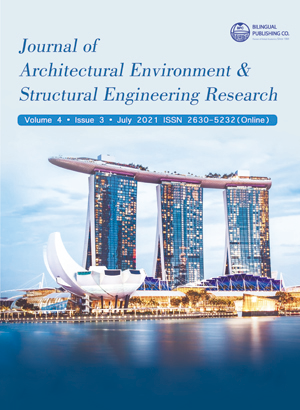-
2127
-
1860
-
1637
-
1593
-
1526
Influence of Selected Curing Techniques on Compressive Strength of Concrete From Palm Kernel Shell Ash and Ordinary Portland Cement
DOI:
https://doi.org/10.30564/jaeser.v4i3.3315Abstract
This paper discusses the findings of an experimental study on the effect of various curing procedures on the compressive strength of concrete produced by partially substituting portland cement with Palm Kernel Shell Ash (PKSA). Palm kernel shell ash was utilized in a 1:2:4 mix ratio as a partial substitute for ordinary Portland cement (OPC) at percentage levels of 0%, 10%, and 15%. River sand with particles passing a 4.75 mm BS sieve was used, as well as crushed aggregate with a maximum size of 20 mm, and palm kernel shell ash with particles passing a 212 μm sieve. The compressive strength of the test cubes (150 mm x 150 mm x 150 mm) was determined after 7, 28, and 56 days of curing. The results demonstrated that test cubes containing Palm kernel shell ash developed strength over a longer curing period than ordinary Portland cement concrete samples and that the strength changes depending on the amount of PKSA in the cube samples. The findings showed that at 28 days, test cubes with 5%, 10%, and 15% PKSA content in all curing procedures utilized obtained a greater compressive strength. Curing by immersion produced the highest compressive strength in all replacement level while the concrete cured by sprinkling and spraying gives a lower strength in all replacement leve
Keywords:
Supplementary cementitious material, Compressive strength, Setting time, Ordinary portland cement, Concrete curingReferences
[1] Z. Z. Jerzy, "Role of concrete curing," 2018. [Online]. Available: http://www.cement.org/learn/concretetechnology/concreteconstruction/curing-in-construction
[2] Lambert Corporation, "Concrete Curing," 1999. [Online]. Available: http://www.lambertusa.com
[3] J. Neil and K. D. Ravindra, Civil Engineering, Basingstoke: Macmillan Education, 1996.
[4] ACI Committee 305, "Hot Weather Concreting," American Concrete Institute, Detroit, 1991.
[5] D. Adepegba , "Pozzolanic activity of palm bunch wastes," Materials and Structure, vol. 22, pp. 220- 224, 1989.
[6] G. A. Akeke, M. E. Ephraim, I. Z. Akobo and J. O. Ukpata, "Structural Properties of Rice Husk Ash in Concrete," International Journal of Engineering and Applied Sciences, vol. 3, no. 3, pp. 57-62, 2013.
[7] J. Rajput, R. K. Yadav and R. Chandak, "The Effect of Rice Husk Ash used as Supplementary Cementing Material on Strength of Mortar," Internal Journal of Engineering Research and Applications, vol. 3, no. 3, pp. 133-136, 2013.
[8] A. A. Raheem, S. O. Oyebisi, S. O. Akintayo and M. I. Oyeniran, "Effects of admixtures on the properties ofcorn cob ash cement concrete," Leonardo Electronic Journal of Practices and Technologies, vol. 16, pp. 13-20, 2010.
[9] A. A. Raheem and D. A. Adesanya, "A study of thermal conductivity of corn cob ash blended cement mortar," The Pacific journal of Science and Technology, vol. 12, no. 2, pp. 106-111, 2011.
[10] J. M. Kinuthia, L. A. Mofor, U. C. Melo and D. Djia, "From ashes to beauty: Utilisation of waste materials for sustainable development in Africa," 2006.
[11] BS EN 197-1, Specification for Portland Cement, London: British Standards Institute, 2000.
[12] Geochemistry Technical Note, "Reference Tables: Element to Oxide Conversion Factors," als global, 2019.
[13] BS EN 1097-5, "Tests for mechanical and physical properties of aggregates. Determination of the water content by drying in a ventilated oven," British Standards Institution, 1999.
[14] BS 812-103.1, Testing aggregates. Method for determination of particle size distribution, London: British Standards Institution, 1985.
[15] BS EN 1097-3, "Tests for mechanical and physical properties of aggregates. Determination of loose bulk density and voids," British Standards Institution, 1998.
[16] BS EN 12620:2002+A1, "Specification for aggregates from natural sources for concrete," British Standards Institution, 2008.
[17] BS EN 196-1, "Methods of testing cement. Determination of strength," British Standards Institution, 2005.
[18] BS EN 1097-2, "Testing Aggregates. Methods for determination of aggregate crushing value and aggregate impact value," British Standards Institution, 2010.
[19] BS EN 12350-2, "Testing concrete. Method for determination of slump," British Standards Institute, 2000.
[20] BS 1891-113:2011, "Testing concrete. Method for making and curing no-fines test cube," British Standards Institution, London, 2011.
[21] BS EN 12390-3, "Testing concrete. Method for determination of compressive strength of concrete cubes," British Standards Institution, 2002.
[22] ASTM C618 - 19, "Standard Specification for Coal Fly Ash and Raw or Calcined Natural Pozzolan for Use in Concrete," ASTM International,, West Conshohocken, 2019.
Downloads
How to Cite
Issue
Article Type
License
Copyright © 2021 Oluwatosin Babatola

This is an open access article under the Creative Commons Attribution-NonCommercial 4.0 International (CC BY-NC 4.0) License.




 Oluwatosin Babatola
Oluwatosin Babatola





